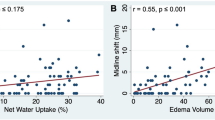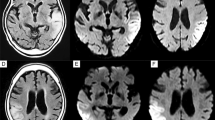Abstract
Background
Posterior reversible encephalopathy syndrome (PRES) is characterized by cerebral blood flow dysregulation and the blood–brain barrier (BBB) disruption. While renal insufficiency has been considered a factor in BBB fragility, the relationship between renal insufficiency and the PRES lesions volume remains unclear.
Methods
This observational study was performed retrospectively. PRES patients were categorized into two groups with renal insufficiency, defined as an estimated glomerular filtration rate (eGFR) of less than 60 mL/min/1.73m2 on the day of symptom occurrence. Lesion volume was measured using fluid-attenuated inversion recovery (FLAIR) imaging, and the brain was divided into nine regions. The volume of the parietal-occipital-temporal lobe was considered typical, while the other six regions were labeled as atypical.
Results
The study included 200 patients, of whom 94 (47%) had renal insufficiency. Patients with renal insufficiency had a larger lesion volume (144.7 ± 125.2 cc) compared to those without renal insufficiency (110.5 ± 93.2 cc; p = 0.032); particularly in the atypical lesions volume (49.2 ± 65.0 vs. 29.2 ± 44.3 cc; p = 0.013). However, there was no difference in the reversibility of the lesions (35.2 ± 67.5 vs. 18.8 ± 33.4 cc; p = 0.129). Multiple regression analysis revealed that decreases in eGFR (β = -0.34, 95% CI -0.62-0.05, p = 0.020) were positively associated with total lesion volume.
Conclusion
Our findings suggest that PRES patients with renal insufficiency experience more severe lesion volumes, likely due to the atypical brain regions involvement. The lesions involving atypical regions may have a similar pathophysiology to typical lesions, as the PRES lesions reversibility was found to be similar between individuals with and without renal insufficiency.


Similar content being viewed by others
Data availability
Upon a reasonable request, the corresponding author can provide the data supporting the findings of this study.
References
Fugate JE, Rabinstein AA (2015) Posterior reversible encephalopathy syndrome: clinical and radiological manifestations, pathophysiology, and outstanding questions. Lancet Neurol 14(9):914–925. https://doi.org/10.1016/S1474-4422(15)00111-8
Siebert E, Bohner G, Liebig T, Endres M, Liman T (2017) Factors associated with fatal outcome in posterior reversible encephalopathy syndrome: a retrospective analysis of the Berlin PRES study. J Neurol 264:237–242. https://doi.org/10.1007/s00415-016-8328-4
Gao B, Lyu C, Lerner A, McKinney AM (2018) Controversy of posterior reversible encephalopathy syndrome: what have we learnt in the last 20 years? J Neurol Neurosurg Psychiatry 89(1):14–20. https://doi.org/10.1136/jnnp-2017-316225
Mueller-Mang C, Mang T, Pirker A, Klein K, Prchla C, Prayer D (2009) Posterior reversible encephalopathy syndrome: do predisposing risk factors make a difference in MRI appearance? Neuroradiology 51:373–383. https://doi.org/10.1007/s00234-009-0504-0
Fugate JE, Claassen DO, Cloft HJ, Kallmes DF, Kozak OS, Rabinstein AA (2010) Posterior reversible encephalopathy syndrome: associated clinical and radiologic findings. Mayo Clinic Proceedings: Elsevier; 427–32. https://doi.org/10.4065/mcp.2009.0590
Liman T, Bohner G, Endres M, Siebert E (2014) Discharge status and in-hospital mortality in posterior reversible encephalopathy syndrome. Acta Neurol Scand 130(1):34–39. https://doi.org/10.1111/ane.12213
Levey AS, James MT (2017) Acute kidney injury. Annal Int Med 167(9):ITC66–ITC80. https://doi.org/10.7326/AITC201711070
Granata G, Greco A, Iannella G, Granata M, Manno A, Savastano E, Magliulo G (2015) Posterior reversible encephalopathy syndrome—insight into pathogenesis, clinical variants and treatment approaches. Autoimmun Rev 14(9):830–836. https://doi.org/10.1016/j.autrev.2015.05.006
Nasu K, Fujisawa M, Kato H, Nangaku M (2017) Three cases of posterior reversible encephalopathy syndrome with chronic kidney disease triggered by infection. Nephrology 22(4):322–325. https://doi.org/10.1111/nep.12930
Moon S-N, Jeon SJ, Choi SS, Song CJ, Chung GH, Yu IK, Kim DH (2013) Can clinical and MRI findings predict the prognosis of variant and classical type of posterior reversible encephalopathy syndrome (PRES)? Acta Radiol 54(10):1182–1190. https://doi.org/10.1177/0284185114545152
Gao B, Liang H, Liu F-l, Lv C (2012) Isolated pons involvement in posterior reversible encephalopathy syndrome in a patient with chronic renal insufficiency: case report and literature review. Clin Neuroradiol 22(4):341–4. https://doi.org/10.1007/s00062-012-0162-1
Casey SO, Sampaio RC, Michel E, Truwit CL (2000) Posterior reversible encephalopathy syndrome: utility of fluid-attenuated inversion recovery MR imaging in the detection of cortical and subcortical lesions. Am J Neuroradiol 21(7):1199–1206
Bălaşa R, Maier S, Baubec EG, Bajko Z, Bălaşa A (2015) Cerebellar and brainstem variant of posterior reversible encephalopathy syndrome. Acta Neurol Belg 115:401–403. https://doi.org/10.1007/s13760-014-0370-3
McKinney AM, Jagadeesan BD, Truwit CL (2013) Central-variant posterior reversible encephalopathy syndrome: brainstem or basal ganglia involvement lacking cortical or subcortical cerebral edema. Am J Roentgenol 201(3):631–638. https://doi.org/10.2214/AJR.12.9677
Fazekas F, Chawluk JB, Alavi A, Hurtig HI, Zimmerman RA (1987) MR signal abnormalities at 1.5 T in Alzheimer’s dementia and normal aging. Am J Neuroradiol 8(3):421–6. https://doi.org/10.2214/ajr.149.2.351
Wardlaw JM, Smith EE, Biessels GJ, Cordonnier C, Fazekas F, Frayne R et al (2013) Neuroimaging standards for research into small vessel disease and its contribution to ageing and neurodegeneration. Lancet Neurol 12(8):822–838. https://doi.org/10.1016/S1474-4422(13)70124-8
Marrone LCP, Martins WA, Borges MT, Rossi BC, Brunelli JPF, Vedana VM et al (2016) Posterior reversible encephalopathy syndrome: clinical differences in patients with exclusive involvement of posterior circulation compared to anterior or global involvement. J Stroke Cerebrovasc Dis 25(7):1776–1780. https://doi.org/10.1016/j.jstrokecerebrovasdis.2016.03.042
Rabinstein AA, Mandrekar J, Merrell R, Kozak OS, Durosaro O, Fugate JE (2012) Blood pressure fluctuations in posterior reversible encephalopathy syndrome. J Stroke Cerebrovasc Dis 21(4):254–258. https://doi.org/10.1016/j.jstrokecerebrovasdis.2011.03.011
Radenkovic M, Stojanovic M, Prostran M (2016) Endothelial dysfunction in renal failure: current update. Curr Med Chem 23(19):2047–2054. https://doi.org/10.2174/0929867323666151231095126
Bai T, Yu S, Feng J (2022) Advances in the role of endothelial cells in cerebral small vessel disease. Front Neurol 13:861714. https://doi.org/10.3389/fneur.2022.861714
Fischer M, Schmutzhard E (2017) Posterior reversible encephalopathy syndrome. J Neurol 264:1608–1616
Pilato F, Distefano M, Calandrelli R (2020) Posterior reversible encephalopathy syndrome and reversible cerebral vasoconstriction syndrome: clinical and radiological considerations. Front Neurol. https://doi.org/10.3389/fneur.2020.00034
Motolese F, Ferrante M, Rossi M et al (2021) Posterior reversible encephalopathy syndrome and brain haemorrhage as COVID-19 complication: a review of the available literature. J Neurol 268:4407–4414
Funding
This work was supported by the Brain Convergence Research Program of the National Research Foundation (NRF) funded by the Korean government (MSIT) (No.2020M3E5D2A01084576) and the National Research Foundation of Korea (NRF) grant funded by the Korean government (MSIT) (No. 2020R1A2C2100077). The funder had no role in the study design, data collection, data analysis, data interpretation, or writing of the Article.
Author information
Authors and Affiliations
Contributions
Writing—original draft preparation: Dong Young Jeong, MD, Bum Joon Kim MD, PhD. Writing – review and editing: Dong Young Jeong, MD, Bum Joon Kim MD, PhD, Sang Hee Ha MD, PhD, Jun Young Chang, MD, PhD, Dong-Wha Kang, MD, PhD, Sun U Kwon MD, PhD. Data curation: Dong Young Jeong, MD, Bum Joon Kim MD, PhD. Conceptualization: Dong Young Jeong, MD, Bum Joon Kim MD, PhD, Yea Na Shin, MD, Sang Hee Ha MD, PhD, Jun Young Chang, MD, PhD, Dong-Wha Kang, MD, PhD, Sun U Kwon MD, PhD. Methodology & Formal analysis and investigation: Dong Young Jeong, MD, Bum Joon Kim MD, PhD, Yea Na Shin, MD, Sang Hee Ha MD, PhD, Jun Young Chang, MD, PhD, Dong-Wha Kang, MD, PhD, Sun U Kwon MD, PhD. Funding acquisition: Bum Joon Kim MD, PhD. Supervision: Bum Joon Kim MD, PhD.
Corresponding author
Ethics declarations
Ethics approval
The study was approved by the local ethics committee (IRB number: 2021–1843), which waived the need for informed consent due to the retrospective nature of the study.
Competing interests
The authors declare that they have no conflict of interest.
Additional information
Publisher's Note
Springer Nature remains neutral with regard to jurisdictional claims in published maps and institutional affiliations.
Supplementary Information
Below is the link to the electronic supplementary material.
Rights and permissions
Springer Nature or its licensor (e.g. a society or other partner) holds exclusive rights to this article under a publishing agreement with the author(s) or other rightsholder(s); author self-archiving of the accepted manuscript version of this article is solely governed by the terms of such publishing agreement and applicable law.
About this article
Cite this article
Jeong, D.Y., Shin, Y.N., Ha, S.H. et al. Association between renal insufficiency and lesion characteristics of posterior reversible encephalopathy syndrome. Neurol Sci (2024). https://doi.org/10.1007/s10072-024-07446-3
Received:
Accepted:
Published:
DOI: https://doi.org/10.1007/s10072-024-07446-3




